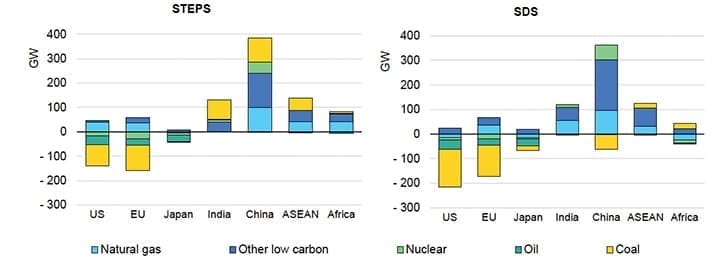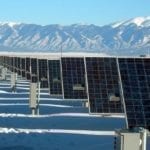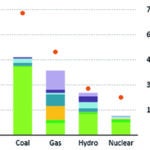At the virtual 2nd Global Ministerial Conference on System Integration of Renewables on Oct. 27, several high-ranking policymakers pointed to a number of localized challenges affecting their countries’ distinctive power systems and clean energy transitions. But most agreed that overall, the biggest threats are entangled within a complex trilemma—and as some suggest, an impossible trinity—of ensuring reliability, affordability, and sustainability.
As he opened the session, Fatih Birol, executive director of the International Energy Agency (IEA), described the issue as a “number one” priority for the IEA. While the Paris-based intergovernmental organization was established to ensure global oil security in the wake of the 1973 oil crisis, its mission has in the decades since expanded to gas security. But ministers had recently asked the IEA “to keep an eye on electricity security,” because, though it accounts for one-fifth of global energy consumption today, “Electricity is essential for the functioning of modern societies—as the COVID-19 crisis has highlighted—and for bringing down global emissions,” Birol said. Electricity’s role in future energy systems, meanwhile, is slated to play a much bigger role in heating, cooling, and transport, as well as for many digitally integrated sectors, such as communication, finance, and healthcare.
In its optimistic sustainable development scenario, the IEA projects that electricity could surpass oil as the world’s largest energy source by 2040. Many countries—specifically those that fall within the Organisation for Economic Co-operation and Development’s (OECD’s) framework—already maintain a high level of electricity security, owing mainly to well-endowed centrally controlled systems and relatively simple supply chains. However, recent technology and policy developments are prompting a radical change within the electricity security model that has prevailed for the past century. Governments and utilities must recognize these emerging threats to reliability, Birol said, and update policies, regulations, and market designs to keep pace with change. The approach will need to be broad and integrate technical, economic, and political levels, he said.
Electricity Security Encapsulates Adequacy, Operational Security, and Resilience
To drive the point home, the IEA on Oct. 27 released a first-of-its-kind report surveying reliability threats in the context of the varied and intense changes across the world’s power systems. Especially notable is the IEA’s precise definition of what it considers “electricity security,” that is, “the electricity system’s capability to ensure uninterrupted availability of electricity by withstanding and recovering from disturbances and contingencies.” The definition, the IEA said, encapsulates three other crucial factors: adequacy, or the “ability of the electricity system to supply the aggregate electrical demand within an area at all times under normal operating conditions”; operational security, which is “the ability of the electricity system to retain a normal state or to return to a normal state after any type of event as soon as possible”; and resilience, or the “ability of the system and its component parts to absorb, accommodate and recover from both short-term shocks and long-term changes.”
In the report, the IEA highlights three types of electricity supply interruptions. These include cascading blackouts, or black-system events, when an initial outage causes the system to collapse from an increasing series of line overloads. “These events are mostly due to equipment failure and simultaneous contingencies, and are very rarely related to lack of installed generation capacity. Recent examples are the Hokkaido blackout in 2018, due to an earthquake, and the South Australian blackout in 2016, which ensued from severe storms and flawed interconnection standards. Load shedding, a system operator’s deliberate disconnection of electrical power as a preventative measure to maintain system balance when supply is expected to be short, is more common. California’s load-shedding event in August 2020 is a prominent example. Finally, some countries suffer long rationing periods of electricity because system operators have to limit power supply on a planned basis owing to large supply and demand deficits. South Africa’s ongoing electricity rationing serves as a cautionary tale of the macroeconomic effects of unreliable supply.
Emerging Risks to Electricity Security
The IEA, specifically, highlighted five emerging risks that threaten electricity security.
 |
|
1. Net additions of dispatchable generation capacity by technology through 2030. Notes: STEPS = Stated Policies Scenario; SDS = Sustainable Development Scenario; EU = European Union; ASEAN = Association of Southeast Asian Nations; and other low carbon includes geothermal, concentrated solar power, biomass, and marine power. Source: IEA World Energy Outlook 2019 |
A Changing Supply Landscape. As variable renewable sources like wind and solar PV become cheaper than thermal power generation, they are flooding markets worldwide. But because they are nonsynchronous generators and do not bring in system inertia, their growth will require substantial flexibility in the system (Figure 1), as well as more elaborate output forecasting. For added resilience against physical supply disruptions and fuel-price fluctuations, the IEA suggested diversifying power supplies (but leaning toward low-carbon sources), ramping up flexibility in supply and demand response. Meanwhile, though distributed generators can be more resilient than centralized systems, operators will also require greater situation awareness.
To ensure all factors are assessed, the IEA urged governments to consider the full slate of electricity complexities as they affect generation, transmission, and distribution in planning frameworks. It also highlighted emerging integrated planning practices, such as inter-regional planning across different jurisdictions and balancing areas; integrated planning across a diversity of supply and demand resources; and integrated planning between the electricity sector and other sectors.
Investment Will Be Crucial for Future System Security. Despite impressive growth in wind and solar PV installment in recent years, overall spending in the power sector “appears to be less than what will be needed to meet forthcoming security challenges,” the IEA said. Resources seeing notable investment slumps, especially owing to the pandemic, include new large-scale dispatchable low-carbon power plants, such as hydropower and nuclear. Spending on natural gas power has also stagnated, and even battery storage investment saw a “leveling off” in 2019. “These trends are clearly misaligned with the future needs of sustainable and resilient power systems,” the IEA said. “Maintaining reliability in the face of greater supply and demand variability will require greater and more timely investments in networks and flexible resources—including demand side, distributed, and storage resources—to ensure that power systems are sufficiently flexible and diverse at all times.”
A Risky Link Between Power Supply Security and Gas Deliverability. As coal, lignite, and nuclear phaseouts continue, more countries are turning to natural gas power to provide flexibility. But this is creating “a more intimate link” between security of electricity supply and natural gas deliverability. “This makes it necessary to assess the deliverability of the gas system, especially when considering declining domestic production and potential closures of gas storage sites,” the IEA warned.
Cybersecurity Is a Continuous Concern. The IEA lauded digitalization’s capabilities to improve power plant efficiency, cost savings, and outage times, as well as to mobilize an array of end-use devices to respond to the power sector’s needs. “Connected devices and the Internet of Things, together with other smart grid technologies, can unlock larger demand response resources, improve energy efficiency, and facilitate the integration of higher shares of variable renewables in a cost-effective and secure manner,” it said. However, the growth in connected devices and distributed energy resources is also “expanding the potential cyberattack surface of electricity systems,” it warned. Since the 2015 attack on the western Ukraine power grid, incidents have increased dramatically. However, while efforts to address cyber risks are growing across the entire global value chain, and governments are implementing policy approaches to cyber resilience, investments and regulatory efforts must keep pace with evolving cyber threats, it said.
Increasing Pressure from Climate Change. Climate change is resulting in rising global temperatures, erratic patterns of precipitation, sea level rise, and more frequent or intense extreme weather events, and this has “significant implications for electricity security,” the IEA said. For generation, the impacts of climate change can reduce the efficiency and alter the availability and generation potential of both thermal and renewable facilities. Transmission and distribution networks can also suffer higher losses, changes in transfer capacity, and physical damage. Climate change’s most uncertain impact, meanwhile, may be its effect on electricity demand, which already varies according to cooling and heating needs. The IEA warned that, so far, even though several countries recognize these risks, only 17 IEA member countries have incorporated concrete electricity security actions—including the three key dimensions of robustness, resourcefulness, and recovery—for climate resilience into national adaption strategies. Of those, only six actions cover the entire value chain.
To manage all these risks, the IEA urged countries to identify, and then work to manage and mitigate risks, and monitor progress. As significant will be plans to respond to and recover from disruptions. These feats will perhaps be best approached by establishing clear responsibilities, incentives, and rules across the electricity system, it said.
—Sonal Patel is a POWER senior associate editor (@sonalcpatel, @POWERmagazine).









